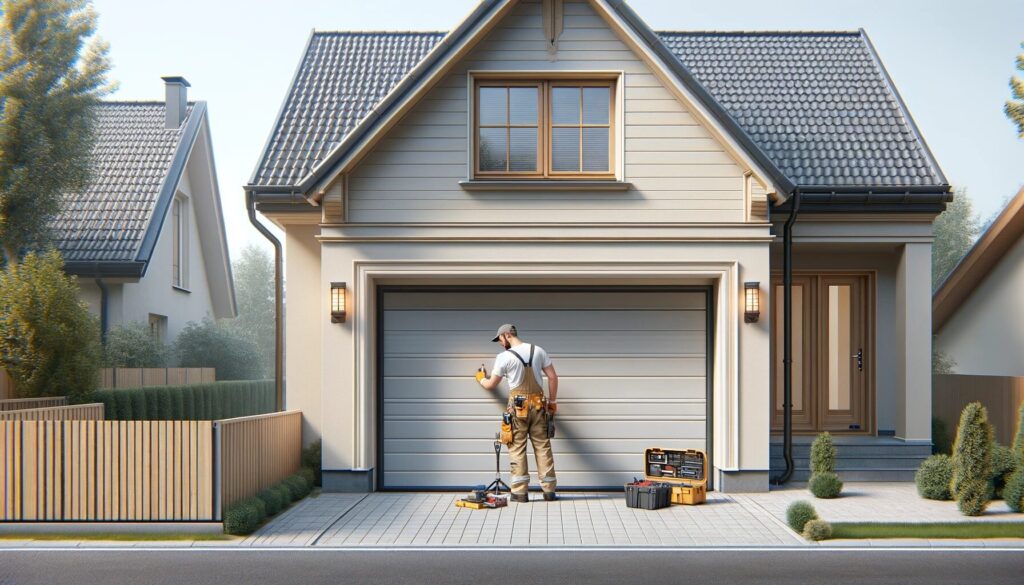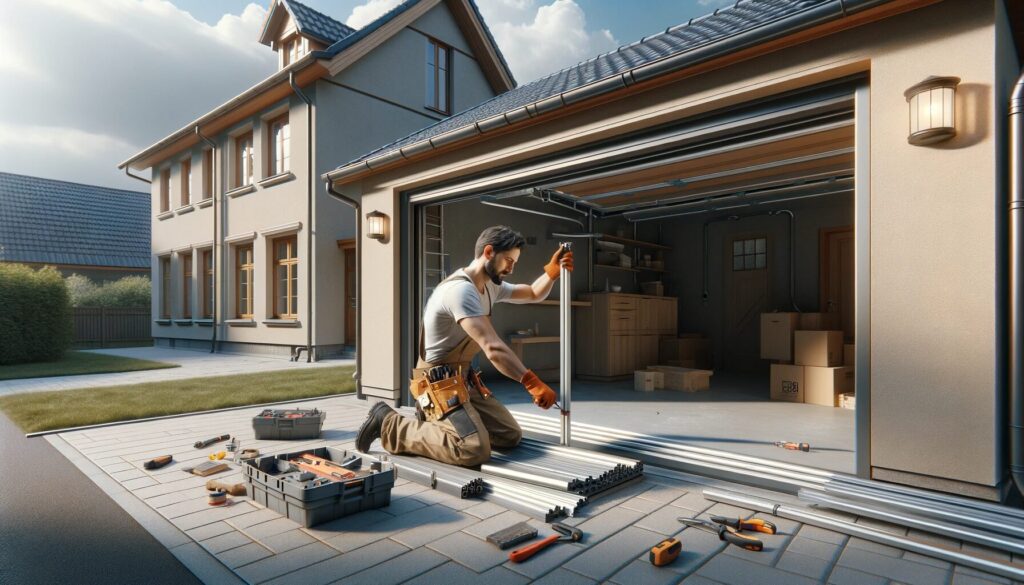When it comes to your home, the garage door is more than just a functional entryway—it’s a key player in your home’s security and curb appeal. Think of it as the face your house shows to the world. It’s crucial to know when it’s time for a change. If your garage door is showing signs of wear and tear, struggling to open or close, or simply not providing the insulation and security it should, it’s time to consider a replacement. This isn’t just about aesthetics, it’s about maintaining the integrity and safety of your home.

Understanding Garage Door Types
The world of garage doors is diverse, each type with its own set of advantages. Let’s break them down:
- Roll-Up Doors: These are the space-savers and are often found in commercial settings, but they’re also suitable for residential garages with limited headroom.
- Sectional Doors: Comprising panel sections connected with hinges, these doors are the most common in residential homes. They’re practical, reliable, and come in various styles and materials.
- Tilt-Up Doors: A bit old-fashioned but still in use, these are single-panel doors that tilt up and slide back into the garage. They require more clearance but offer a unique aesthetic.
Materials are equally varied:
- Wood: Offers a traditional look but requires regular maintenance to protect against weather and wear.
- Steel: Extremely durable and low-maintenance but can be prone to dents and rust.
- Aluminum: Lightweight and rust-resistant, ideal for large doors.
- Fiberglass: Resistant to dents, cracking, and warping, it’s a good compromise between the natural look of wood and the durability of synthetic materials.
Tools and Materials Needed for Garage Door Replacement
Here’s a practical toolkit list for this job:
- Wrenches and Socket Set: For tightening and loosening nuts and bolts.
- Screwdrivers: A variety of sizes will come in handy.
- Level: Essential for ensuring your installation is perfectly horizontal.
- Tape Measure: Accuracy is key in measurements.
- Locking Pliers and Vice Grips: These will help hold things in place.
- Safety Glasses and Gloves: Never compromise on safety.
- Drill with Bits: For making pilot holes and securing screws.
- Hammer: Sometimes you need a bit of force.
In terms of materials, you’ll need the garage door itself, along with the tracks, springs (torsion or extension), rollers, cables, and brackets. Choose quality materials, this is about long-term safety and functionality.
Preparing for Replacement
When it’s time to bid farewell to your old garage door, precision and safety are your top priorities. Here’s how to prepare:
- Power Off: Always start by disconnecting the power to ensure a safe work environment, especially if you have an automatic opener.
- Ease the Tension: Dealing with torsion springs? This step is crucial. Releasing tension in these springs requires careful handling to avoid accidents.
- Panel by Panel: Methodically unscrew and remove each panel. This step-by-step dismantling prevents any sudden shifts in weight and balance.
- Track and Spring Removal: With the door panels out, it’s time to remove the tracks and springs. This should be done cautiously, keeping in mind the springs still hold residual tension.
Measuring for your new door is not just about getting the dimensions right, it’s about ensuring a seamless fit. Measure twice: width, height, headroom, and backroom. This is not just a good practice – it’s essential for a smooth installation.

Step-by-Step Guide to Installing a New Garage Door
Installing a new garage door is a process that demands attention to detail:
- Panel Installation: Start with the lowest panel. Place it in the opening and secure it loosely with nails. Ensure it’s level before proceeding.
- Set Up the Tracks and Rollers: After placing the bottom panel, attach the rollers and the vertical tracks. Check for vertical alignment (plumb) and then secure them.
- Assemble Remaining Panels: Continue adding and securing each panel, attaching rollers and hinges as you go. This is where a systematic approach pays off.
- Spring Installation: Whether you’re dealing with torsion or extension springs, follow the manufacturer’s guidelines closely. Precision here is not just about functionality, it’s about safety.
Alignment and balance are vital. The tracks must be perfectly aligned, and the door should stay in place when left half-open. If it doesn’t, you’ll need to adjust the springs.
Safety Considerations
In garage door installation, your safety is paramount:
- Springs: If there’s one aspect where caution is non-negotiable, it’s when handling springs. Their tension is immense and can cause serious injury if not handled properly.
- The Right Tools for the Job: Using the correct tools is not only about efficiency, it’s about safety. The right tool will do the job without risking injury.
- Secure Tracks: Ensure that the tracks are firmly secured to the wall. Any instability here can lead to the door malfunctioning.
- Protective Gear: Don’t overlook the importance of gloves and safety glasses. They are simple safeguards against a range of potential injuries.
Post-installation, it’s wise to conduct several test runs to ensure smooth operation. Regular maintenance is the key to longevity and safety. A properly installed garage door does more than open and close smoothly, it contributes to the overall security and energy efficiency of your home.
Maintenance Tips for Your New Garage Door
Regular maintenance is the key to ensuring your garage door’s longevity and reliable performance. Let’s go through some essential maintenance practices:
- Lubrication: Regularly lubricating the moving parts of your garage door, like the rollers, springs, and hinges, is crucial. A specialized garage door lubricant works best, providing smooth operation and reducing wear.
- Balance Check: Periodically check the balance of your door. Disconnect the opener and manually move the door halfway up. If it doesn’t stay put, the springs may require adjustment, a task often best left to professionals due to the high tension in the springs.
- Hardware Tightening: The constant motion can loosen the door’s hardware. Use a socket wrench to tighten all the bolts and screws periodically to ensure everything stays in place.
- Roller Inspection: Inspect the rollers, whether steel or nylon, for wear and tear. Chipped, worn, or cracked rollers should be replaced to prevent door malfunction.
- Weatherstripping Replacement: The weatherstripping at the bottom of the door plays a vital role in insulating and protecting your garage from the elements. If it’s brittle or broken, replacing it can significantly improve the door’s efficiency.
Troubleshooting Common Issues
Encountering issues with your garage door can be frustrating, but many common problems have simple solutions:
- Improper Operation: If your door isn’t opening or closing correctly, check for misaligned tracks or a potential spring issue. In cases of broken springs or tracks, professional assistance is advised for safety.
- Noisy Door: A noisy garage door often indicates worn rollers or a need for lubrication. Tightening loose hardware can also reduce noise.
- Remote Control Troubles: Start with the basics – check the batteries. If the issue persists, inspect the opener’s antenna. Sometimes, remotes need reprogramming or replacement.
In instances where you’re unsure, or the problem seems complex, consulting a professional is a wise decision to prevent further damage or potential injury.
Enhancing Your Garage Door
Customizing your garage door can add a personal touch and enhance your home’s curb appeal:
- Painting: A new paint job can rejuvenate your garage door. Choose a color that complements your house or opt for something bold for a standout look.
- Adding Windows: Windows not only improve the appearance of your garage door but also bring in natural light. They can be retrofitted into existing doors or chosen as a feature in new doors.
- Smart Garage Door Openers: Upgrading to a smart opener provides convenience and security. These openers allow for remote operation through smartphones, integration with home security systems, and can include features like automatic closing schedules.
FAQ Section
Signs indicating the need for a replacement include extensive damage, operational issues, or lack of energy efficiency compared to modern doors.
This depends on your skill level and comfort with potential risks, especially regarding spring systems. Professional installation ensures safety and proper setup.
Costs vary widely, depending on the type of door, materials, and whether you’re installing it yourself or hiring a professional. Prices can range from a few hundred to several thousand dollars.
For experienced individuals or professionals, the job can be completed in a day. If you’re new to this, it might take a weekend.
This depends on your locality. Some areas require permits, especially for significant renovations. Always check with your local building authority.
Consider factors like the architectural style of your home, the local climate, and your budget. Your choice of materials (wood, steel, fiberglass) will impact both the look and functionality of the door.
